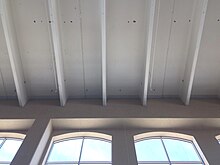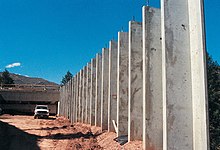
Prestressed concrete is a form of concrete used in construction. It is substantially "prestressed" (compressed) during production, in a manner that strengthens it against tensile forces which will exist when in service.
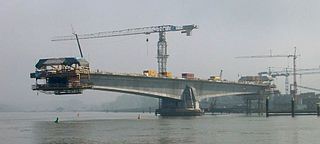
A cantilever bridge is a bridge built using structures that project horizontally into space, supported on only one end. For small footbridges, the cantilevers may be simple beams; however, large cantilever bridges designed to handle road or rail traffic use trusses built from structural steel, or box girders built from prestressed concrete.

A multistorey car park or parking garage, also called a multistory, parking building, parking structure, parkade, parking ramp, parking deck or indoor parking, is a building designed for car, motorcycle and bicycle parking and where there are a number of floors or levels on which parking takes place. The first known multistory facility was built in London in 1901, and the first underground parking was built in Barcelona in 1904. The term multistory is almost never used in the US, since parking structures are almost all multiple levels. Parking structures may be heated if they are enclosed.

Bangabandhu Bridge, also known as the Jamuna Multi-purpose Bridge is a bridge opened in Bangladesh in June 1998. It connects Bhuapur on the Jamuna River's east bank to Sirajganj on its west bank. It was the 11th longest bridge in the world when constructed in 1998 and at present is the 6th longest bridge in South Asia. The Jamuna River, which it spans, is one of the three major rivers of Bangladesh, and is fifth largest in the world in discharge volume.

Steel frame is a building technique with a "skeleton frame" of vertical steel columns and horizontal I-beams, constructed in a rectangular grid to support the floors, roof and walls of a building which are all attached to the frame. The development of this technique made the construction of the skyscraper possible.

A girder is a beam used in construction. It is the main horizontal support of a structure which supports smaller beams. Girders often have an I-beam cross section composed of two load-bearing flanges separated by a stabilizing web, but may also have a box shape, Z shape, or other forms. Girders are commonly used to build bridges.

Precast concrete is a construction product produced by casting concrete in a reusable mold or "form" which is then cured in a controlled environment, transported to the construction site and maneuvered into place; examples include precast beams, and wall panels for tilt up construction. In contrast, cast-in-place concrete is poured into site-specific forms and cured on site.

A girder bridge is a bridge that uses girders as the means of supporting its deck. The two most common types of modern steel girder bridges are plate and box.

The original Walnut Lane Memorial Bridge was a prestressed concrete girder bridge in Philadelphia, Pennsylvania, designed by Belgian Engineer Gustave Magnel and built by the City of Philadelphia. Completed and fully opened to traffic in 1951, this three-span bridge carried Walnut Lane over Lincoln Drive and Monoshone Creek. It was the first major prestressed concrete beam bridge designed and built in the United States when completed.

La Vicaria Bridge is a through arch bridge that spans the Segura River, where it meets La Fuensanta Reservoir near Yeste, in the province of Albacete, Spain. It forms part of a future road that will join Yeste with Letur and the neighbouring area to the east. The bridge has 2 vehicle lanes and 2 sidewalks.

Voided biaxial slabs, sometimes called biaxial slabs or voided slabs, are a type of reinforced concrete slab which incorporates air-filled voids to reduce the volume of concrete required. These voids enable cheaper construction and less environmental impact. Another major benefit of the system is its reduction in slab weight compared with regular solid decks. Up to 50% of the slab volume may be removed in voids, resulting in less load on structural members. This also allows increased weight and/or span, since the self-weight of the slab contributes less to the overall load.

The Northam Bridge is a road bridge across the River Itchen in Southampton, England, linking the suburbs of Northam and Bitterne Manor. The current bridge was the first major prestressed concrete road bridge to be built in the United Kingdom. The bridge carries the A3024 road as a dual carriageway, with two lanes on each carriageway.

A T-beam, used in construction, is a load-bearing structure of reinforced concrete, wood or metal, with a T-shaped cross section. The top of the T-shaped cross section serves as a flange or compression member in resisting compressive stresses. The web of the beam below the compression flange serves to resist shear stress. When used for highway bridges the beam incorporates reinforcing bars in the bottom of the beam to resist the tensile stresses which occur during bending.
Spancrete is an American manufacturer of precast concrete products and machinery. Spancrete produces precast, prestressed concrete products that are used in commercial, industrial, institutional, residential and multifamily construction projects in the Midwest and Southeast. The company also manufactures and sells hollowcore extrusion machines that are used to produce precast concrete internationally.
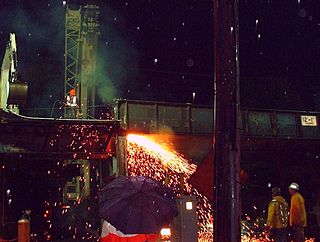
Rapid bridge replacement or accelerated bridge construction (ABC) is a technique that allows bridges to be replaced with minimum disruption to traffic. The replacement bridge is constructed on a site near the bridge to be replaced. When it is completed, the old bridge is cut away and removed using self-propelled modular transporters (SPMTs). Then the SPMTs lift the new bridge, transfer it to the work site and put it in place. Often the highway or railroad carried by the bridge is closed for just one weekend. Conventional techniques typically replace half a bridge at a time, with all highway traffic redirected under the other bridge half, often for a year or more, while construction progresses. Accelerated bridge construction (ABC) alternatives consist of ABC components and ABC techniques. Components can be categorized into prefabricated bridge elements or prefabricated bridge systems. ABC involves fabrication of these elements or systems off-site in a regulated environment, and transporting those to site for installation. Related processes such as lifting, placement, transportation, embankment construction are termed as ABC techniques.

Kolbjørn Saether P.E., M.ASCE was an American structural engineer in the City of Chicago for 47 years. Saether dedicated his life to engineering and was known as a leader in his field. He was a past director of the Structural Engineers Association of Illinois and was the organization's president from 1980 to 1981. During his career he developed innovative engineering solutions for skyrise building construction that are now part of the Chicago skyline, published theoretical insights to enhance the state of the art in structural engineering, and patented novel techniques to advance the art of building construction.
This glossary of structural engineering terms pertains specifically to structural engineering and its sub-disciplines. Please see glossary of engineering for a broad overview of the major concepts of engineering.
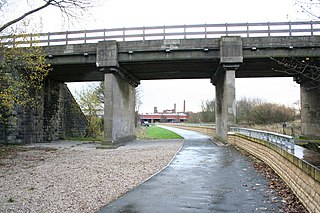
The Adam Viaduct is a grade II listed concrete underbridge in Wallgate, Wigan. The bridge, constructed in 1946, is the earliest prestressed concrete railway bridge in the United Kingdom, with only some examples in Switzerland being earlier. It is bridge number 54 on the Kirkby branch line and is at a line distance of 18 miles 1,032 yards (29.91 km).
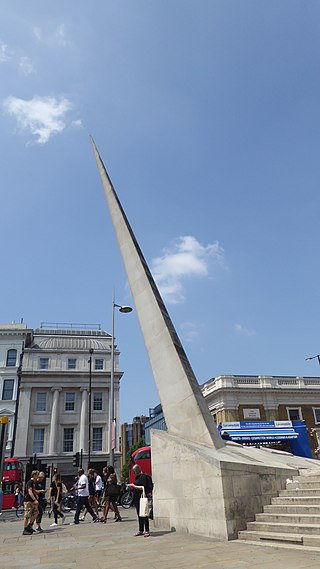
Post-tensioned stone is a high-performance composite construction material: stone held in compression with tension elements. The tension elements can be connected to the outside of the stone, but more typically uses tendons threaded internally through a duct formed from aligned drilled holes.

